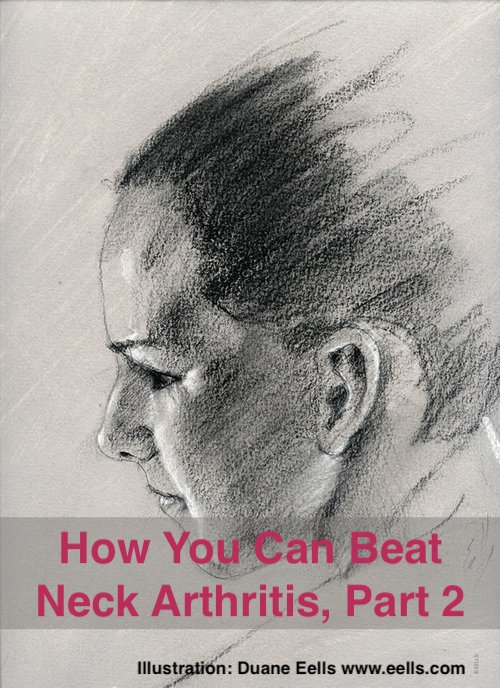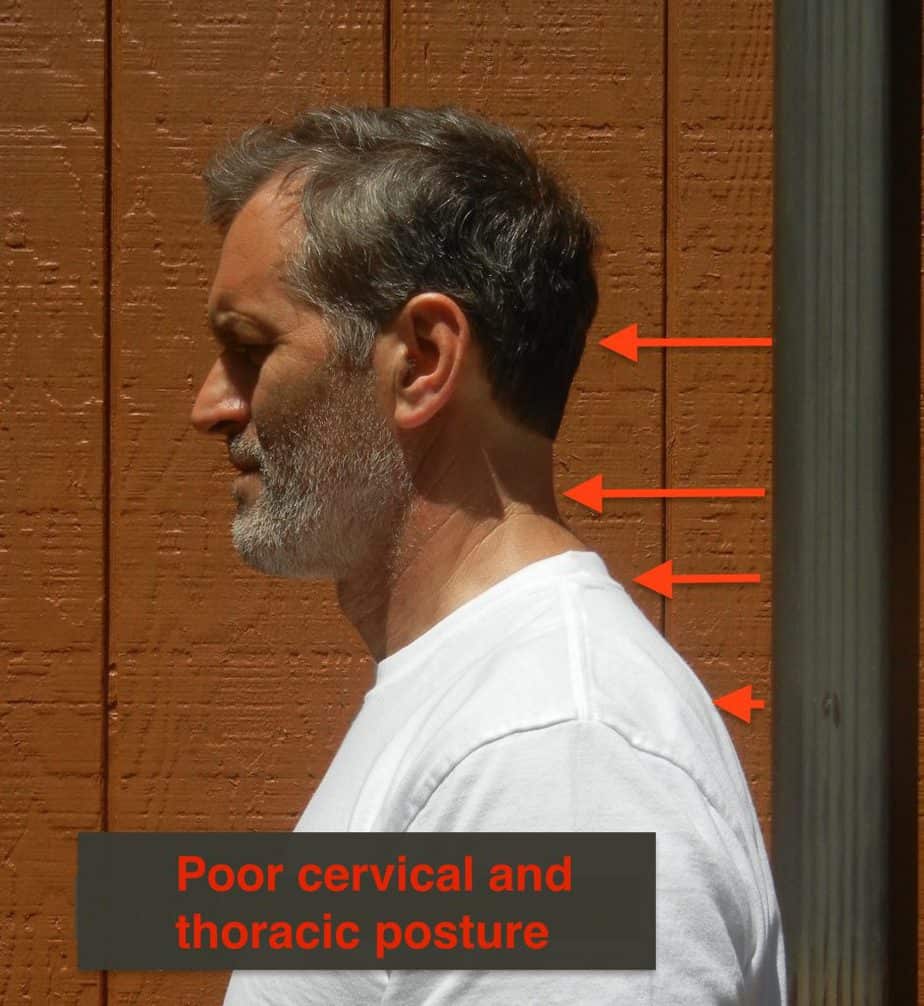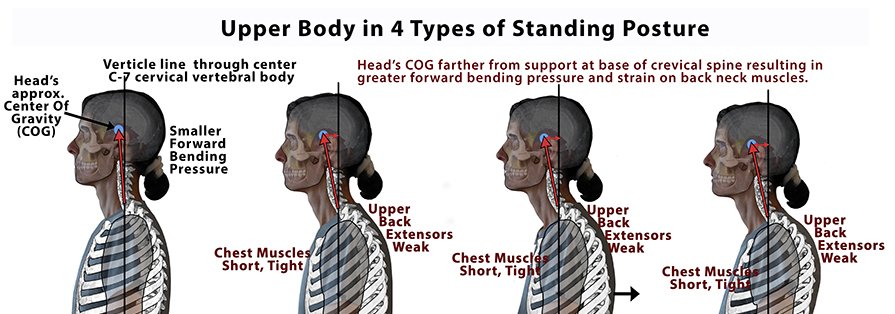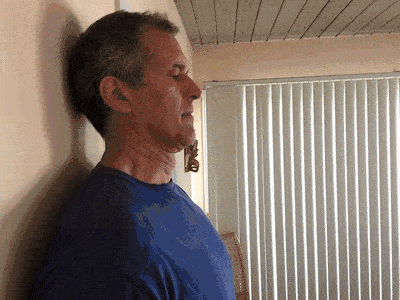How You Can Beat Neck Arthritis, Part 2
Arthritis is inevitable, particularly in the neck, because neck arthritis can be the result of too much time sitting at a desk with your head forward and down peering at a computer screen or smart phone — things many of us do all the time. Watch the video, check out the pics and learn what to do to prevent and improve neck arthritis.
Part 1 covered the difference between osteoarthritis and rheumatoid arthritis, how arthritis is diagnosed and treated, a general idea of the type of exercises to do and specific foods to eat and supplements to take to help alleviate the pain and mobility restrictions of arthritis.
Here in Part 2 the focus is neck arthritis.
If your upper spine and neck are hunched forward, you have neck pain or lack of mobility when turning your head side to side or up and down, you need to read on and watch the videos.
In this article, we’ll cover:
- What is neck arthritis;
- How to prevent neck arthritis;
- Neck arthritis symptoms;
- Neck arthritis diagnosis and treatments;
- Neck arthritis responds to exercise; and
- The supplements proven to help beat arthritis.
Let’s dig in…
What Is Neck Arthritis?
Arthritis comes in various forms, but the two most of us get in one or more joints in our body are osteoarthritis or rheumatoid arthritis, particularly in our Golden Years.
Osteoarthritis (“OS”) occurs when the protective cartilage in a joint begins to break down and no longer facilitates smooth movement between bones, which can eventually result in the joint becoming swollen and painful. When this condition develops in the cervical spine, it is called cervical osteoarthritis.
Rheumatoid arthritis (“RA”), in contrast to osteoarthritis, is a type of arthritis in which your body’s immune system attacks healthy tissue in your joints. This is symptomatic of an autoimmune disease, which means the body’s immune system attacks healthy tissue, usually affecting the hands, wrists, elbows, knees, ankles and feet. And, yes, the neck as well.
The joint involvement of rheumatoid arthritis is symmetrical; for instance, if one shoulder is affected the other likely will be as well. With rheumatoid arthritis, the inflammation occurs in joints on both sides of the body, a symmetry that helps distinguish it from other types of arthritis.
Although the cause of rheumatoid arthritis is different than with osteoarthritis, in both cases you suffer from inflammation, lack of joint mobility and pain; therefore, foods, exercises and supplements that address these symptoms have the potential to be useful irrespective of the kind of arthritis you have.
So, how does this specifically apply to neck arthritis?
A quick anatomy lesson would be helpful, courtesy of Spine-health.com:
Remember these three things from the video:
- The seven vertebrae of the cervical spine are connected in the back by paired facet joints, which allow for forward and backward extensions, as well as twisting movements. These facet joints can wear down over time and lead to cervical spinal stenosis or osteoarthritis.
- In between the vertebrae are six cervical discs that act as shock absorbers and allow flexibility and movement of the neck. These discs may herniate or degenerate, either through wear and tear over time or from an injury.
- A number of cervical spine conditions may inflame or irritate the nerve roots that branch off of the spinal cord and exit in the back of the spine, resulting in pain that radiates down the arms and possibly fingers, known as cervical radiculopathy.
OK, now that you have a sense of what it is, let’s spend a minute reviewing how to prevent neck arthritis from happening to you.
How To Prevent Neck Arthritis
Before I get into symptoms, diagnosis and treatment, let’s review some helpful tips on how to prevent or delay neck arthritis if you don’t already have it.
Learn stretching exercises. Consult a physical therapist if necessary. You should stretch every day especially before and after you exercise (see examples below). If after exercising, your neck hurts, apply ice immediately and then alternate between heat and ice.
Consume magnesium. Notwithstanding arthritis, neck pain is most frequently the result of a muscle strain or sprain. Increasing your intake of magnesium — a mineral that aids in the contraction and relaxation of muscles — may help avoid pain- causing symptoms. Some pointers:
- Magnesium is commonly found in fruits, vegetables, beans, soy products, and whole grains. Read the nutrition labels on products to see how much of your daily-recommended amount of magnesium they provide.
- Magnesium can be absorbed through the skin by taking a warm bath with Epsom salt.
- Some people have success with the use of magnesium oil applied directly to wherever they’re sore after a warm shower or bath. I do this myself and use the Ancient Minerals brand. (Note: all magnesium oils itch and slightly burn when applied, but both sensations cease within a few minutes.)
Keep your back and neck supported. This is a must, especially sitting at your computer. If your computer is at eye level, it will keep you from having to look up and down and constantly change your neck position. Use a headset when talking on the telephone to avoid straining your neck.
Don’t sit at a desk day. Invariably your head will slump forward while sitting at a desk and staring down at your computer or smart phone.
Don’t cradle your phone on your neck. You may not even realize that you’re aggravating your neck is by cradling your phone while you’re talking. This puts unneeded strain on your cervical spine. Moreover, people experience “text neck” by craning their neck down to look at their phone while they text or browse the internet. Do this instead:
- Use a Bluetooth or hands-free headset to make calls.
- When you’re browsing or texting, hold the phone up high to decrease the angle at which you’re holding your neck.
- Take frequent breaks to stretch your neck.
Sleep with the support of a firm mattress and the right pillow. If your neck is sore in the morning, consider getting a special neck pillow that supports your head and neck. (I use this memory foam contour pillow.)
Use your seat belt. Protect yourself from neck trauma by always using a seat belt when riding in a car.
Now you know what to do to prevent neck arthritis, but maybe it’s too late. You’ve got a nagging feeling that it’s no longer a question of prevention but of diagnosis and treatment. Before you consult a doctor, let’s review some neck arthritis symptoms.
Neck Arthritis Symptoms
You know something’s wrong with your neck if it’s causing you pain and your neck mobility is restricted. Specifically, symptoms of cervical, or neck arthritis, may include:
- Hunched upper back
- Forward leaning head
- Neck stiffness and pain
- Pain that may radiate into the arms
- Numbness or weakness in the arms and hands
- Numbness or weakness in the legs or feet that may lead to problems with balance
- Neck popping or neck cracking, or grinding or clicking sounds in the neck
- Muscle spasms in the neck
- Headaches
- Irritability
- Fatigue
- Trouble sleeping
If any of this is happening consistently, it’s time to get diagnosed and begin treatment. The longer you wait, the worse the wear and tear on your cervical joints.
Neck Arthritis Diagnosis and Treatment
Consider making an appointment with a doctor if your symptoms do not go away in a week or two with self care; if you have numbness, tingling, or weakness in your arm or hand; if you have difficulty swallowing or breathing along with the neck pain; or if the pain was caused by an injury that prevents full movement of your arm or hand.
An osteopath, orthopedic medical doctor or chiropractor can make a proper diagnosis of neck arthritis.
To diagnose neck arthritis your doctor will ask you questions about your symptoms and perform a physical exam. A physical test many doctors administer is to have you touch your chin to your chest. You may also need to undergo imaging studies, such as X-rays or an MRI (magnetic resonance imaging), so that your doctor can view the vertebrae, disks, and ligaments of the neck and look for any abnormalities, such as bone spurs, that may be contributing to your symptoms.
Treatment options for neck arthritis include:
- Limiting neck movement, which may mean wearing a cervical collar.
- Non-steroidal anti-inflammatory drugs (NSAIDs) or other pain medication to help relieve your pain and inflammation.
- Physical therapy.
- Heat therapy.
- Ice therapy.
- Exercises to improve poor posture.
- Chiropractic manipulation.
- Neck exercise to strengthen and stretch the cervical spine.
- Neck steroid injections in some cases.
- In rare cases, surgery may be necessary to relieve pressure on the spinal cord from bone spurs or a herniated disk.
- Warm epsom salt baths.
- Herbal remedies with anti-inflammatory properties, such as curcumin and bosweillia (see below).
- Yoga exercise, which involves stretches, poses, and meditation, is not only a great exercise, but it also relieves stress and neck pain by reducing tension.
- Massage your neck where it hurts for temporary relief. It sure helps if someone does this for you.
Neck Arthritis Responds to Exercise
I’ve already touched on this, and now it’s time for a deeper dive into the benefits derived from mobility, stretch and strengthening exercises for the neck.
By now you know that for many of us aging is literally be a pain in the neck. That’s because degeneration of the cervical vertebrae occurs in nearly everyone as they age. Think abut it — you’ve been holding up an eight to ten pound head for decades, the equivalent of a bowling ball propped up and balanced on tiny neck bones.
Fortunately, says Arthritis.org, researchers have determined that simple exercises can provide plenty of relief regardless of the cause of the pain. A randomized, controlled trial at Punkaharju Rehabilitation Center in Finland studied the effectiveness of strength training in the neck, compared with stretching or no exercise. The study was comprised of 180 women, aged 25 to 53, who did office work and had chronic neck pain.
Results showed that strength-training exercises worked best to relieve neck pain, with up to three-quarters of the women reporting “considerable or complete” pain relief. One year after the study, the women’s improved neck strength remained, and their ability to look up, down and sideways was greatly improved – ten times better than in the control group.
The strength-training group used an elastic resistance band for one set of exercises. Double-check with your doctor or physical therapist before trying this strengthening exercise at home.
- Sit up straight in a chair and put the back of your head in the loop of the resistance band, the ends of which should be securely tied to a nearby stationary object that is level with your head.
- Make sure your neck and back stay straight as you slightly lean forward from your hips. Your head will move forward about one foot.
- Slowly return to the starting position, keeping shoulders back as you keep your neck straight.
- Repeat 15 times.
Frankly, I don’t like to read about how an exercise should be done; rather, I want to see it. I do an exercise similar to what’s described above to improve my forward-leaning head, which I’ll show you in a moment, but first, check out this pic of me:
That vertical structure behind me is a drain pipe that’s perpendicular to the ground. My spine is not. It’s not supposed to be like a pencil, but it needs to get straighter than it is. Ideally, our spines should follow a specific curvature, like the image below on the left hand side, as opposed to the other three images:
I do the following exercise, along with the next five, every morning during the mobility phase of my 10 morning rituals.
The exercise shown above help a lot to strengthen the neck, rhomboids and trapezius muscles and counteract the neck-forward posture many of us get from sitting at a desk and, frankly, simply aging.
I use one of the bands from this resistance band set, a highly recommended, versatile apparatus to add to your workout equipment.
To do the above exercise:
- Position your body against a wall, heels, butt, upper back, neck and head as flat against the wall as you can.
- Wrap and elastic band above your ears and extend it to the tension length desired, and then fix that tension by keeping your arm extended and in place. Notice that I don’t move my arm.
- Being careful not to bend your head down, allow your chin to jut out and then pull it back, keeping the tension in the band.
- Move slowly, do as many repetitions as you can until you feel weary, and slowly work up to multiple sets.
Here are more neck exercises useful for arthritis or any particular neck weakness or misalignment, courtesy of Healthline.com:
- Neck drop and raise
- Head tilt
- Neck rotation
- Neck retraction
- Shoulder rolls
Move gently and smoothly through each exercise, at the same pace shown below. Don’t make any sudden movements or jerk your neck — twisting and turning your neck is done in the neck rotation exercise. And of course, stop if any exercise increases your neck pain.
Neck drop and raise
Head tilt
Beware the tendency to drop your ear forward, rather than to the shoulder.
Neck rotation
Neck retraction
Shoulder rolls
Had enough exercise yet?
Hope not… because there’s more, courtesy of Dr. Ben Kim and physical therapist Jeff Cavaliere. Check out these two videos — they will do your neck and upper spine a world of good!
Supplements for Neck Arthritis
There are no supplements tailored for arthritis in the neck, as opposed to arthritis in any other joint, that I know about. I took a deep dive on this topic in Part 1, and recommend you take a peek.
Here are the top six, so named because of the robustness of the studies indicating their effectiveness:
| Supplement | Arthritis Focus | Recommended By |
| Boswellia Serrata | OA | Arthritis.org (proven), Examine.com (proven) |
| Curcumin | OA and RA | Arthritis.org (proven), Examine.com (proven) |
| Fish Oil | OA and RA | Arthritis.org (proven), Examine.com (proven) |
| Glucosamine Sulfate | OA | Examine.com (proven) |
| Chondroitin | OA | Examine.com (proven) |
| Vitamin C | No mention | Examine.com (proven) |
Go to Part 1 and see the rest of the arthritis-relieving supplements that aren’t necessary proven, but listed by Examine.com and Arthritis.org as possibly useful.
Your Takeaway
Well, there’s a lot to digest in this piece, but your neck will thank you if you’ve diligently read through the text and watched the video — if you put enough of it into practice.
Here are three things to remember:
- Most of us will get some sort of arthritis eventually, simply because our joints wear out over time.
- Having arthritis doesn’t mean your time of care-free, pain-free movement is over. That said, you must attend to the issue and do the best you can to beat back arthritis.
- Exercises such as the ones demonstrated above, which stretch, strengthen and mobilize the joints substantially help reduce pain and improve function as do the supplements in many cases.
I hope you share this arthritis series with your friends and family. It will help with a chronic condition that for most of us is inevitable, because it’s just part of living, eventually.
The Arthritis Series
- Part 1 How You Can Beat Arthritis
- Part 2 How You Can Beat Arthritis In Your Neck (You’re reading this one now.)
- Part 3 How You Can Beat Arthritis In Your Shoulders
- Part 4 How You Can Beat Arthritis In Your Elbows and Writs
- Part 5 How You Can Beat Arthritis In Your Lower Back
- Part 6 How You Can Beat Arthritis In Your Hips
- Part 7 How You Can Beat Arthritis In Your Knees and Ankles
Last Updated on January 19, 2020 by Joe Garma






